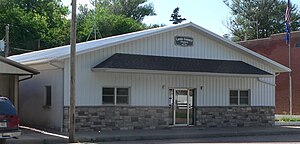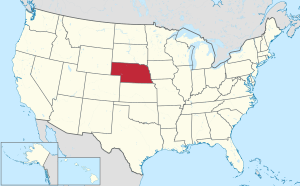Loup County is a county in the U.S. state of Nebraska. As of the 2020 United States Census, the population was 607,[1] making it Nebraska's fifth-least populous county and the tenth-least populous county in the United States. Its county seat is Taylor.[2] The county was named after the Pawnee Loup Indians.[3]
Loup County | |
|---|---|
 Loup County Courthouse in Taylor | |
 Location within the U.S. state of Nebraska | |
 Nebraska's location within the U.S. | |
| Coordinates: 41°56′N 99°27′W / 41.93°N 99.45°W | |
| Country | |
| State | |
| Founded | 1883 |
| Seat | Taylor |
| Largest village | Taylor |
| Area | |
• Total | 571 sq mi (1,480 km2) |
| • Land | 568 sq mi (1,470 km2) |
| • Water | 2.8 sq mi (7 km2) 0.13% |
| Population (2020) | |
• Total | 607 |
| • Density | 1.1/sq mi (0.41/km2) |
| Time zone | UTC−6 (Central) |
| • Summer (DST) | UTC−5 (CDT) |
| Congressional district | 3rd |
| Website | www |
In the Nebraska license plate system, Loup County is represented by the prefix 88 (it had the eighty-eighth-largest number of vehicles registered in the county when the license plate system was established in 1922).
Geography
editThe terrain of Loup County consists of low corrugated flatland, sparsely used for agricultural purposes at present. The ground slopes to the southeast. The Calamus River runs southeastward through the upper center of the county, feeding into the Calamus Reservoir which lies on the county's east border. The North Loup River also runs southeastward through the lower center of the county, exiting eastward near the SE corner to run to its junction with the Calamus River at a point east of Loup County.[4] The county has an area of 571 square miles (1,480 km2), of which 568 square miles (1,470 km2) is land and 2.8 square miles (7.3 km2) (0.5%) is water.[5]
Major highways
editAdjacent counties
edit- Holt County – northeast
- Garfield County – east
- Custer County – south
- Blaine County – west
- Brown County – northwest
- Rock County – north
Protected area
edit- Calamus River State Recreation Area[6]
Demographics
edit| Census | Pop. | Note | %± |
|---|---|---|---|
| 1890 | 1,662 | — | |
| 1900 | 1,305 | −21.5% | |
| 1910 | 2,188 | 67.7% | |
| 1920 | 1,946 | −11.1% | |
| 1930 | 1,818 | −6.6% | |
| 1940 | 1,777 | −2.3% | |
| 1950 | 1,348 | −24.1% | |
| 1960 | 1,097 | −18.6% | |
| 1970 | 854 | −22.2% | |
| 1980 | 859 | 0.6% | |
| 1990 | 683 | −20.5% | |
| 2000 | 712 | 4.2% | |
| 2010 | 632 | −11.2% | |
| 2020 | 607 | −4.0% | |
| 2022 (est.) | 599 | −1.3% | |
| US Decennial Census[7] 1790-1960[8] 1900-1990[9] 1990-2000[10] 2010[11] 2020 2022[12] | |||
As of the 2000 United States Census,[13] there were 632 people, 289 households, and 206 families in the county. The population density was 1.1 people per square mile (0.42 people/km2). There were 377 housing units at an average density of 0.7 units per square mile (0.27/km2). The racial makeup of the county was 98.88% White, 0.28% Native American, 0.14% Asian, 0.42% from other races, and 0.28% from two or more races. 1.69% of the population were Hispanic or Latino of any race.
There were 289 households, out of which 31.80% had children under the age of 18 living with them, 64.70% were married couples living together, 4.20% had a female householder with no husband present, and 28.40% were non-families. 27.00% of all households were made up of individuals, and 17.00% had someone living alone who was 65 years of age or older. The average household size was 2.46 and the average family size was 2.99.
The county population contained 26.70% under the age of 18, 4.50% from 18 to 24, 22.30% from 25 to 44, 27.00% from 45 to 64, and 19.50% who were 65 years of age or older. The median age was 43 years. For every 100 females, there were 108.80 males. For every 100 females age 18 and over, there were 100.00 males.
The median income for a household in the county was $26,250, and the median income for a family was $27,788. Males had a median income of $20,515 versus $20,972 for females. The per capita income for the county was $12,427. About 14.20% of families and 17.70% of the population were below the poverty line, including 22.90% of those under age 18 and 11.60% of those age 65 or over.
Communities
editVillage
edit- Taylor (county seat)
Unincorporated communities
edit- Almeria
- Pioneerville pop: 106 (2010)
Ghost towns
edit- Clothstock, Inhabited: 1899–1907, Highest population: 38 (1906)
- Pickiner, Inhabited: 1908–1926, Highest population: 76 (1918)
Politics
editLoup County voters have been strongly Republican since the beginning. In only two national elections since 1900 has the county selected the Democratic Party candidate.
| Year | Republican | Democratic | Third party(ies) | |||
|---|---|---|---|---|---|---|
| No. | % | No. | % | No. | % | |
| 2020 | 370 | 81.50% | 75 | 16.52% | 9 | 1.98% |
| 2016 | 323 | 83.90% | 48 | 12.47% | 14 | 3.64% |
| 2012 | 290 | 81.01% | 62 | 17.32% | 6 | 1.68% |
| 2008 | 302 | 76.84% | 86 | 21.88% | 5 | 1.27% |
| 2004 | 314 | 81.35% | 68 | 17.62% | 4 | 1.04% |
| 2000 | 284 | 75.13% | 84 | 22.22% | 10 | 2.65% |
| 1996 | 229 | 68.77% | 74 | 22.22% | 30 | 9.01% |
| 1992 | 234 | 59.69% | 59 | 15.05% | 99 | 25.26% |
| 1988 | 295 | 73.75% | 98 | 24.50% | 7 | 1.75% |
| 1984 | 323 | 79.95% | 79 | 19.55% | 2 | 0.50% |
| 1980 | 368 | 78.30% | 74 | 15.74% | 28 | 5.96% |
| 1976 | 299 | 65.57% | 140 | 30.70% | 17 | 3.73% |
| 1972 | 345 | 85.61% | 58 | 14.39% | 0 | 0.00% |
| 1968 | 331 | 76.44% | 64 | 14.78% | 38 | 8.78% |
| 1964 | 348 | 66.41% | 176 | 33.59% | 0 | 0.00% |
| 1960 | 445 | 77.53% | 129 | 22.47% | 0 | 0.00% |
| 1956 | 441 | 76.03% | 139 | 23.97% | 0 | 0.00% |
| 1952 | 507 | 82.31% | 109 | 17.69% | 0 | 0.00% |
| 1948 | 294 | 52.78% | 263 | 47.22% | 0 | 0.00% |
| 1944 | 488 | 72.84% | 182 | 27.16% | 0 | 0.00% |
| 1940 | 539 | 65.10% | 289 | 34.90% | 0 | 0.00% |
| 1936 | 438 | 55.65% | 335 | 42.57% | 14 | 1.78% |
| 1932 | 287 | 40.83% | 389 | 55.33% | 27 | 3.84% |
| 1928 | 594 | 83.78% | 106 | 14.95% | 9 | 1.27% |
| 1924 | 285 | 47.98% | 105 | 17.68% | 204 | 34.34% |
| 1920 | 343 | 66.73% | 117 | 22.76% | 54 | 10.51% |
| 1916 | 164 | 38.05% | 219 | 50.81% | 48 | 11.14% |
| 1912 | 131 | 28.60% | 113 | 24.67% | 214 | 46.72% |
| 1908 | 248 | 53.91% | 170 | 36.96% | 42 | 9.13% |
| 1904 | 223 | 66.57% | 23 | 6.87% | 89 | 26.57% |
| 1900 | 149 | 51.56% | 137 | 47.40% | 3 | 1.04% |
See also
editReferences
edit- ^ "Loup County, Nebraska". United States Census Bureau. Retrieved June 19, 2023.
- ^ "Find a County". National Association of Counties. Retrieved June 7, 2011.
- ^ Gannett, Henry (1905). The Origin of Certain Place Names in the United States. Government Printing Office. p. 191.
- ^ Loup County NE Google Maps (accessed 23 January 2019)
- ^ "2010 Census Gazetteer Files". US Census Bureau. August 22, 2012. Archived from the original on November 13, 2013. Retrieved December 9, 2014.
- ^ Calamus Reservoir State Recreation Area Google Maps (accessed 23 January 2019)
- ^ "US Decennial Census". US Census Bureau. Retrieved December 9, 2014.
- ^ "Historical Census Browser". University of Virginia Library. Retrieved December 9, 2014.
- ^ "Population of Counties by Decennial Census: 1900 to 1990". US Census Bureau. Retrieved December 9, 2014.
- ^ "Census 2000 PHC-T-4. Ranking Tables for Counties: 1990 and 2000" (PDF). US Census Bureau. Archived (PDF) from the original on March 27, 2010. Retrieved December 9, 2014.
- ^ https://www.census.gov/quickfacts/fact/table/loupcountynebraska/PST045222.
{{cite web}}: Missing or empty|title=(help) - ^ "State & County QuickFacts". US Census Bureau. Archived from the original on June 7, 2011. Retrieved September 21, 2013.
- ^ "U.S. Census website". United States Census Bureau. Retrieved January 31, 2008.
- ^ Election Results